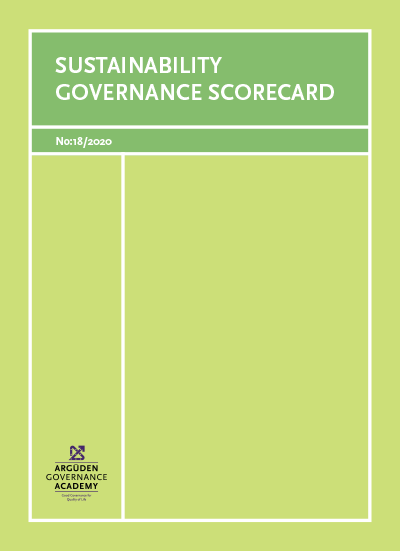Checklist for Responsible Boards
Sustainability Vision
into the Organization
35 Sustainability Questions for Responsible Board Members
CRAFTING THE SUSTAINABILITY VISION
Comprehensive Scope: Does the board have a sustainability charter with appropriate scope?
- 1Does it include all areas of sustainability, such as safety, health, environmental and community impact, human rights, labor rights, anti‑corruption, and business ethics?
- 2Does it include the responsibilities throughout the value chain?
- 3Does it include product responsibilities throughout the lifecycle of the corporation’s full product portfolio?
- 4Does it include highest standards of conduct in all the jurisdictions that the corporation operates in?
Stakeholder Engagement: Has an adequate stakeholder engagement process been conducted?
- 5Has the management comprehensively identified its relevant stakeholders and prepared a stakeholder map?
- 6Has the management identified sustainability initiatives targeting each stakeholder group through two‑way communication?
- 7Does the board have access to the key issues raised by this process?
- 8Does the board have a process to evaluate management’s sustainability plans to address the key issues?
Materiality and Risk Management: Have the material issues been properly identified that would substantively affect the company’s strategy, business model, capital, or performance?
- 9Has the board been involved in setting the materiality thresholds in each sustainability area (economic, environmental, and social)?
- 10Have the trends as well as current and future impacts been considered?
- 11Has management prioritized the key sustainability issues?
- 12Has management considered resource requirements to deal with the prioritized issues in its mitigation plans?
BUILDING SUSTAINABLE BOARDS
Skills and Team: Does the board have the right skills to provide guidance and oversight to the sustainability plans of the corporation?
- 13Does the board have sufficient expertise to understand the decision‑making processes of key stakeholders?
- 14Does the board have members who are familiar with the evolving sustainability standards and benchmarks?
- 15Does the board have enough diversity to adequately evaluate the different dimensions, perspectives, and risks of the sustainability issues? For example, does it have diversity in the following areas:
- Industry experience—to better understand benchmarking opportunities
- Tenure—to avoid groupthink
- Age—to better understand the sensitivities of different cohorts of customers and stakeholders
- Ethnic, gender, and geographic—to better understand the sensitivities of different social segments and markets
- Stakeholder experience—to better understand the decision‑making processes of different stakeholders
Processes: Does the board have the right processes to provide guidance and oversight to the sustainability plans of the corporation?
- 16Has the board established a special sustainability committee to review the sustainability risks and plans, to highlight the key issues for the full board to consider?
- 17Does the board understand the sustainability risks and impacts across the corporation’s value chain and how this might affect the competitive positioning of the corporation?
- 18Does the board provide guidance on incorporation of sustainability issues into corporate strategy and the company’s focus on sustainability‑driven innovation and value‑creation opportunities?
- 19Does the board provide sufficient oversight to the management’s identification of risks and opportunities concerning sustainability issues, including those related to strategy, regulatory and legal liability, product development and pricing, and disclosure and reputation, as well as the management’s action plans?
- 20Does the board have access to outside experts on various dimensions of sustainability, who can provide second opinions on management reports on sustainability issues?
- 21Has the board allocated specific and sufficient time during its annual time budget to adequately review the sustainability issues for the corporation?
- 22Does the board conduct a regular self‑evaluation exercise that incorporates the board’s approach and effectiveness in providing guidance and oversight on sustainability issues?
- 23Does the board D&O insurance package sufficiently protect the directors against liabilities arising from sustainability issues, and does the corporation incorporate the recommendations of the insurers into its sustainability plans?
Timely and Adequate Information: Does the board receive timely and adequate information to evaluate the performance of the corporation’s sustainability plans?
- 24Does the board regularly receive sufficient information about sustainability performance of the corporation, including comparisons with past performance and budget targets (oversight of the quality of implementation)?
- 25How about lead indicators, current trends, emerging issues, emerging benchmarks, compliance with applicable laws and regulations, and the critical upcoming regulations and standards (continuous learning)?
- 26Is information about the level of intellectual capital and reputation of the corporation measured and made available to the board?
- 27Does the board receive on a timely basis findings and recommendations concerning the corporation’s sustainability matters from any investigation or audit by the internal audit department, external auditors, regulatory agencies, the corporation’s insurance companies, or third‑party consultants?
INTEGRATING SUSTAINABILITY INTO THE ORGANIZATION
Leadership and Culture
- 28Are the sustainability issues that are identified and approved by the board incorporated into the corporation’s strategies, policies, objectives, and associated management systems (value‑creation opportunities)?
- 29Has the corporation allocated sufficient resources to address these sustainability issues (sustainability of the efforts)?
- Financial resources
- Organizational/human resources
- Intellectual resources
- Any significant changes to the plans and resource requirements (which should be reported to the board)
Deployment and Accountability
- 30Are all the executives and key employees of the corporation in different geographies familiar with the sustainability priorities of the corporation (deployment)?
- 31Does the board link sustainability performance metrics with the remuneration policy for top management (incentives)?
- 32Does the board have an explicit policy for those who fail to follow the sustainability standards of the corporation (remedies)?
- 33How does the board ensure continuous learning regarding developing sustainability issues—within the organization as well as throughout the supply chain?
Transparency and Reporting
- 34Has the board adopted a disclosure policy for the corporation’s sustainability program, and does it review the disclosure on management approach to sustainability?
- 35How does the board assure itself that the sustainability reporting by the company is adequate, appropriate, and verifiable?



